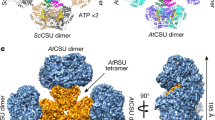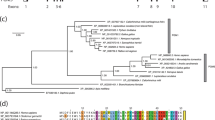Abstract
Enzymes catalyse specific reactions and are essential for maintaining life. Although some are referred to as being bifunctional, they consist of either two distinct catalytic domains or a single domain that displays promiscuous substrate specificity1. Thus, one enzyme active site is generally responsible for one biochemical reaction. In contrast to this conventional concept, archaeal fructose-1,6-bisphosphate (FBP) aldolase/phosphatase (FBPA/P) consists of a single catalytic domain, but catalyses two chemically distinct reactions of gluconeogenesis: (1) the reversible aldol condensation of dihydroxyacetone phosphate (DHAP) and glyceraldehyde-3-phosphate (GA3P) to FBP; (2) the dephosphorylation of FBP to fructose-6-phosphate (F6P)2. Thus, FBPA/P is fundamentally different from ordinary enzymes whose active sites are responsible for a specific reaction. However, the molecular mechanism by which FBPA/P achieves its unusual bifunctionality remains unknown. Here we report the crystal structure of FBPA/P at 1.5-Å resolution in the aldolase form, where a critical lysine residue forms a Schiff base with DHAP. A structural comparison of the aldolase form with a previously determined phosphatase form3 revealed a dramatic conformational change in the active site, demonstrating that FBPA/P metamorphoses its active-site architecture to exhibit dual activities. Thus, our findings expand the conventional concept that one enzyme catalyses one biochemical reaction.
This is a preview of subscription content, access via your institution
Access options
Subscribe to this journal
Receive 51 print issues and online access
$199.00 per year
only $3.90 per issue
Buy this article
- Purchase on Springer Link
- Instant access to full article PDF
Prices may be subject to local taxes which are calculated during checkout



Similar content being viewed by others
References
Moore, B. Bifunctional and moonlighting enzymes: lighting the way to regulatory control. Trends Plant Sci. 9, 221–228 (2004)
Say, R. F. & Fuchs, G. Fructose 1,6-bisphosphate aldolase/phosphatase may be an ancestral gluconeogenic enzyme. Nature 464, 1077–1081 (2010)
Nishimasu, H., Fushinobu, S., Shoun, H. & Wakagi, T. The first crystal structure of the novel class of fructose-1,6-bisphosphatase present in thermophilic archaea. Structure 12, 949–959 (2004)
Rashid, N. et al. A novel candidate for the true fructose-1,6-bisphosphatase in archaea. J. Biol. Chem. 277, 30649–30655 (2002)
Sato, T. et al. Genetic evidence identifying the true gluconeogenic fructose-1,6-bisphosphatase in Thermococcus kodakaraensis and other hyperthermophiles. J. Bacteriol. 186, 5799–5807 (2004)
St-Jean, M. & Sygusch, J. Stereospecific proton transfer by a mobile catalyst in mammalian fructose-1,6-bisphosphate aldolase. J. Biol. Chem. 282, 31028–31037 (2007)
St-Jean, M., Lafrance-Vanasse, J., Liotard, B. & Sygusch, J. High resolution reaction intermediates of rabbit muscle fructose-1,6-bisphosphate aldolase: substrate cleavage and induced fit. J. Biol. Chem. 280, 27262–27270 (2005)
Choi, K. H., Shi, J., Hopkins, C. E., Tolan, D. R. & Allen, K. N. Snapshots of catalysis: the structure of fructose-1,6-(bis)phosphate aldolase covalently bound to the substrate dihydroxyacetone phosphate. Biochemistry 40, 13868–13875 (2001)
Huber, R. & Bennett, W. S., Jr Functional significance of flexibility in proteins. Biopolymers 22, 261–279 (1983)
Bustamante, C., Chemla, Y. R., Forde, N. R. & Izhaky, D. Mechanical processes in biochemistry. Annu. Rev. Biochem. 73, 705–748 (2004)
Tousignant, A. & Pelletier, J. N. Protein motions promote catalysis. Chem. Biol. 11, 1037–1042 (2004)
Due, A. V., Kuper, J., Geerlof, A., Kries, J. P. & Wilmanns, M. Bisubstrate specificity in histidine/tryptophan biosynthesis isomerase from Mycobacterium tuberculosis by active site metamorphosis. Proc. Natl Acad. Sci. USA 108, 3554–3559 (2011)
Otwinowski, Z. & Minor, W. Processing of X-ray diffraction data collected in oscillation mode. Methods Enzymol. 276, 307–326 (1997)
Emsley, P., Lohkamp, B., Scott, W. G. & Cowtan, K. Features and development of Coot. Acta Crystallogr. D 66, 486–501 (2010)
Murshudov, G. N., Vagin, A. A. & Dodson, E. J. Refinement of macromolecular structures by the maximum-likelihood method. Acta Crystallogr. D 53, 240–255 (1997)
Acknowledgements
We thank O. Nureki for discussions, and the staff of the Photon Factory for the X-ray data collection.
Author information
Authors and Affiliations
Contributions
S.F. collected the diffraction data and determined the crystal structure. H.N. prepared the wild-type and mutant proteins and crystallized the wild-type protein. D.H. prepared and crystallized the wild-type protein. D.H. and H.-J.S. measured the enzyme activity. S.F., H.N. and T.W. conceived the project and wrote the manuscript. All authors commented on the manuscript.
Corresponding author
Ethics declarations
Competing interests
The authors declare no competing financial interests.
Supplementary information
Supplementary Information
The file contains Supplementary Tables 1-2, Supplementary Figures 1-8 with legends and Supplementary References. (PDF 4063 kb)
Rights and permissions
About this article
Cite this article
Fushinobu, S., Nishimasu, H., Hattori, D. et al. Structural basis for the bifunctionality of fructose-1,6-bisphosphate aldolase/phosphatase. Nature 478, 538–541 (2011). https://doi.org/10.1038/nature10457
Received:
Accepted:
Published:
Issue Date:
DOI: https://doi.org/10.1038/nature10457
This article is cited by
-
Remote loop evolution reveals a complex biological function for chitinase enzymes beyond the active site
Nature Communications (2024)
-
Catalytic site flexibility facilitates the substrate and catalytic promiscuity of Vibrio dual lipase/transferase
Nature Communications (2023)
-
Bacterial bug-out bags: outer membrane vesicles and their proteins and functions
Journal of Microbiology (2020)
-
Pcal_0111, a highly thermostable bifunctional fructose-1,6-bisphosphate aldolase/phosphatase from Pyrobaculum calidifontis
Extremophiles (2017)
-
Flux Control in Glycolysis Varies Across the Tree of Life
Journal of Molecular Evolution (2016)
Comments
By submitting a comment you agree to abide by our Terms and Community Guidelines. If you find something abusive or that does not comply with our terms or guidelines please flag it as inappropriate.



